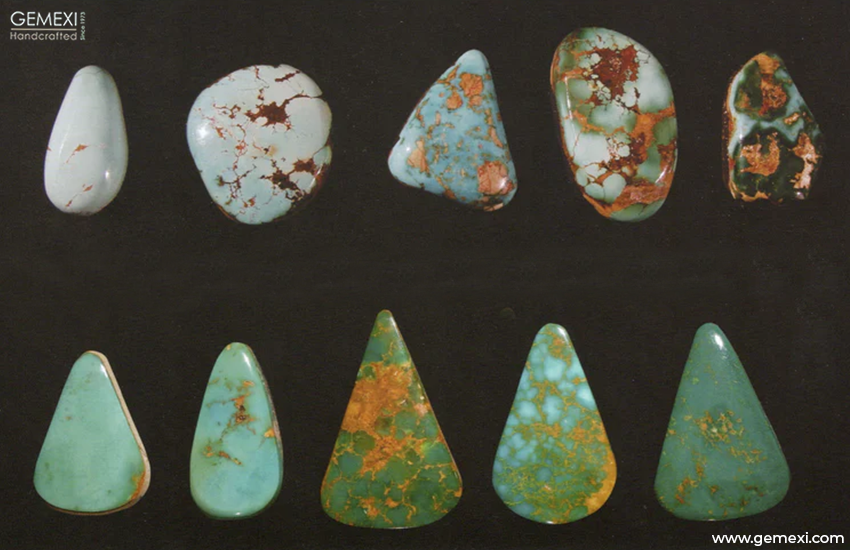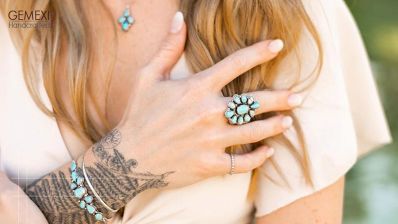Turquoise Types and Their Storied History
By Gemexi Team | Turquoise- Updated On Jun 14, 2023

Turquoise, an opaque, blue-to-green mineral that has been cherished by civilizations across history for its unique beauty and spiritual significance, is perhaps one of the most intriguing gemstones on the planet. Its distinctive hues, drawn from copper, aluminum, and phosphate, make it instantly recognizable. This gemstone is primarily sourced from arid regions, with primary sources being Iran, the Southwestern United States, China, and Egypt. However, not all turquoise is the same; there are different types that vary due to variations in their mineral content, porosity, and location of extraction.
I. Persian Turquoise
Persian Turquoise is renowned worldwide for its uniform, robin’s egg blue color without any matrix, the network of veins that are often present in the stone. This form of turquoise, mined in Iran's Neyshabur region, has been prized since ancient times. It was often used in the decorative arts, notably in the grand architecture of Persian palaces and mosques. Persian Turquoise became a significant trade commodity along the Silk Road, adorning the royal courts of Egypt, India, and Russia. It's noteworthy that despite the presence of modern imitations, genuine Persian Turquoise remains highly sought after by gemstone connoisseurs.
II. American Turquoise
American Turquoise, sourced primarily from the Southwestern United States, is another major type of turquoise. This turquoise is characterized by a higher concentration of copper, which gives it a range of colors from sky blue to green. The most famous American Turquoise mines are in Arizona, New Mexico, Nevada, and Colorado. Each mine produces turquoise with distinctive colors and patterns of matrix, making American Turquoise as diverse as the landscapes from which it is sourced.
Perhaps the most celebrated American Turquoise comes from Arizona’s Sleeping Beauty Mine. This turquoise is known for its light blue color and lack of matrix, making it similar in appearance to Persian Turquoise. The Kingman Mine, also in Arizona, is famous for its turquoise with a high copper content, rendering it a bright blue with a black, silver, or gold matrix. Nevada's Royston Mine is well-regarded for producing turquoise in a unique variety of green and blue hues. The matrix in Royston Turquoise often appears as golden brown to dark brown, offering a striking contrast to the green and blue.
Perhaps the most celebrated American Turquoise comes from Arizona’s Sleeping Beauty Mine. This turquoise is known for its light blue color and lack of matrix, making it similar in appearance to Persian Turquoise. The Kingman Mine, also in Arizona, is famous for its turquoise with a high copper content, rendering it a bright blue with a black, silver, or gold matrix. Nevada's Royston Mine is well-regarded for producing turquoise in a unique variety of green and blue hues. The matrix in Royston Turquoise often appears as golden brown to dark brown, offering a striking contrast to the green and blue.
III. Chinese Turquoise
Chinese Turquoise has been mined in the Hubei Province and the Ma'ashan mines for over two thousand years, making it a significant part of Chinese culture. Chinese Turquoise generally has a greenish-blue to light green color due to the lower copper content and higher iron and aluminum content. Chinese Turquoise often has a matrix that can be black, brown, or yellow, making it distinctly different from the Persian and American types. It has been used in traditional Chinese medicine and viewed as a symbol of wealth and prosperity.
IV. Egyptian Turquoise
Egyptian Turquoise, historically mined in the Sinai Peninsula, is known to be among the first turquoises to be used by humans, dating back to the First Dynasty. Its colors range from blue to green, often veined with dark brown or black matrix due to the presence of iron compounds. Ancient Egyptians valued turquoise for its protective qualities, adorning pharaohs and sacred objects with this vibrant stone. The famous burial mask of Pharaoh Tutankhamun, for instance, showcases turquoise inlays alongside gold and other precious gems.
The allure and appeal of turquoise continue to resonate today, with its rich, storied history and unique properties only enhancing its value. Understanding the different types of turquoise not only enriches one’s appreciation for this ancient gemstone but also allows for informed decisions when purchasing turquoise jewelry or artifacts.
The allure and appeal of turquoise continue to resonate today, with its rich, storied history and unique properties only enhancing its value. Understanding the different types of turquoise not only enriches one’s appreciation for this ancient gemstone but also allows for informed decisions when purchasing turquoise jewelry or artifacts.










0 Comments
Write Comments